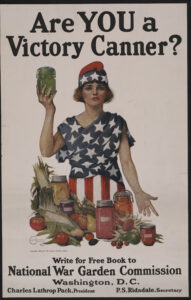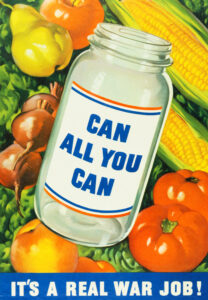Yes, You Can! — Preserving Summer’s Bounty, Historically and Today

It’s high summer, and produce is everywhere: in the garden, at the farmer’s market, at farm stands…there’s even locally-grown produce in grocery stores. Want to have some of that summer goodness at your fingertips long after the season is over? Try canning and preserving! It’s easy, it can be fun — really! — and, historically, it’s even been seen as a patriotic duty and a logical partner to victory gardens. Read on to find out more!
Victory gardens first made an appearance in World War I as a result of appeals from the United States government. “Food will win the war!” was the motto of the newly-formed U.S. Food Administration, and Americans did their part by planting food gardens at home and leaving commercial farms to produce food for soldiers. Preserving that home-grown food was a natural offspring of the victory garden movement:

“In this war the question of food goes hand in hand with thrift. We must all set our minds to one thing: winning the war, and victory is to be brought about by our ability to produce food, and save it after we have produced it.” (Charles Lathrop Pack, President of the National War Garden Commission, in Home Canning and Drying of Vegetables and Fruits)
The campaign was so successful that, when U.S. involvement in World War II began in 1941, Americans were again asked to take up the shovel, plant seeds of victory and, of course, preserve the surplus. The U.S. Department of Agriculture again reminded women to “fight famine by canning at home.” And, again, food became a weapon for victory, with clean plates being a sign of virtue while waste was quite the opposite.
With Ohio Memory, we can also learn a bit about what women were canning, including the recipes they used. Before we proceed, though, there is one crucial thing to remember: while these recipes can be used as inspiration, and you might even be able to follow them line for line, you should always look to current guidelines for the preservation of foods. Science has come along way in the past 100 years, and food preservation practices have changed tremendously. Grandma may have been using the exact same steps for canning green beans for the past fifty years, and those steps might even be the same ones her mother followed, or her mother’s mother, and so on, but that doesn’t make the preservation process safe. For best results, visit Healthy Canning or the National Center for Home Food Preservation (note: links will take you to sites unaffiliated with Ohio Memory) for information on safe preservation practices.
For a handful of years in the late 1930s and early 1940s, The Sun (North Canton) ran a regular feature called “The Jelly Shelf.” None of its recipes are complicated, and all call for ingredients still grown today or found at the local market. While the safety advice in the previous paragraph is important to keep in mind, it shouldn’t stop you from trying out the jams, jellies, relishes and conserves that are found in The Sun’s pages, as you may not find these recipes elsewhere. For example, this recipe for Watermelon Chow Chow makes use of watermelon rind, which is typically discarded. On that same page you’ll find a recipe for Grape Butter which, presumably, has the consistency of apple butter and looks delicious. By visiting this link, you’ll find several more issues of The Sun and its “The Jelly Jar” feature.

The Sun isn’t the only source of recipes that you’ll find in Ohio Memory, however. Take a look here for some delicious-looking pickling recipes for, courtesy of The Worthington News, July 30, 1942. You might also check out the Orwell News-Letter from September 9, 1943, for some great recipes and information on how to choose good pickling cucumbers for maximum crispness, what to look for in a pickling salt, and what equipment you’ll need.
Finally, take a look at the National War Garden pamphlet linked above and here. Many of its instructions — inspecting your equipment and jars; use only “sound” fruits and vegetables; have everything in place prior to starting your recipe — hold true today. Plus, sprinkled throughout are recipes for fruit butters, pickles, relishes, catsup, and dried produce that you may be able to follow exactly; just, again, process according to current guidelines.
Are you preserving food this season? Do you have a go-to recipe to share? We’d love for you to tell us about it!
Thank you to Shannon Kupfer-Trausch, Digital Initiatives Librarian at the State Library of Ohio, for this week’s post!



Leave a Reply
You must be logged in to post a comment.